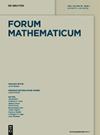求助PDF
{"title":"On 𝐿𝑝 boundedness of rough Fourier integral operators","authors":"Guoning Wu, Jie Yang","doi":"10.1515/forum-2023-0443","DOIUrl":null,"url":null,"abstract":"In this paper, we deal with the <jats:inline-formula> <jats:alternatives> <m:math xmlns:m=\"http://www.w3.org/1998/Math/MathML\"> <m:msup> <m:mi>L</m:mi> <m:mi>p</m:mi> </m:msup> </m:math> <jats:inline-graphic xmlns:xlink=\"http://www.w3.org/1999/xlink\" xlink:href=\"graphic/j_forum-2023-0443_ineq_0001.png\"/> <jats:tex-math>L^{p}</jats:tex-math> </jats:alternatives> </jats:inline-formula> boundedness of rough Fourier integral operators <jats:inline-formula> <jats:alternatives> <m:math xmlns:m=\"http://www.w3.org/1998/Math/MathML\"> <m:msub> <m:mi>T</m:mi> <m:mrow> <m:mi>a</m:mi> <m:mo>,</m:mo> <m:mi>φ</m:mi> </m:mrow> </m:msub> </m:math> <jats:inline-graphic xmlns:xlink=\"http://www.w3.org/1999/xlink\" xlink:href=\"graphic/j_forum-2023-0443_ineq_0002.png\"/> <jats:tex-math>T_{a,\\varphi}</jats:tex-math> </jats:alternatives> </jats:inline-formula> with amplitude <jats:inline-formula> <jats:alternatives> <m:math xmlns:m=\"http://www.w3.org/1998/Math/MathML\"> <m:mrow> <m:mrow> <m:mi>a</m:mi> <m:mo></m:mo> <m:mrow> <m:mo stretchy=\"false\">(</m:mo> <m:mi>x</m:mi> <m:mo>,</m:mo> <m:mi>ξ</m:mi> <m:mo stretchy=\"false\">)</m:mo> </m:mrow> </m:mrow> <m:mo>∈</m:mo> <m:mrow> <m:msup> <m:mi>L</m:mi> <m:mi mathvariant=\"normal\">∞</m:mi> </m:msup> <m:mo></m:mo> <m:msubsup> <m:mi>S</m:mi> <m:mi>ρ</m:mi> <m:mi>m</m:mi> </m:msubsup> </m:mrow> </m:mrow> </m:math> <jats:inline-graphic xmlns:xlink=\"http://www.w3.org/1999/xlink\" xlink:href=\"graphic/j_forum-2023-0443_ineq_0003.png\"/> <jats:tex-math>a(x,\\xi)\\in L^{\\infty}S_{\\rho}^{m}</jats:tex-math> </jats:alternatives> </jats:inline-formula> and phase function <jats:inline-formula> <jats:alternatives> <m:math xmlns:m=\"http://www.w3.org/1998/Math/MathML\"> <m:mrow> <m:mrow> <m:mi>φ</m:mi> <m:mo></m:mo> <m:mrow> <m:mo stretchy=\"false\">(</m:mo> <m:mi>x</m:mi> <m:mo>,</m:mo> <m:mi>ξ</m:mi> <m:mo stretchy=\"false\">)</m:mo> </m:mrow> </m:mrow> <m:mo>∈</m:mo> <m:mrow> <m:msup> <m:mi>L</m:mi> <m:mi mathvariant=\"normal\">∞</m:mi> </m:msup> <m:mo></m:mo> <m:msup> <m:mi mathvariant=\"normal\">Φ</m:mi> <m:mn>2</m:mn> </m:msup> </m:mrow> </m:mrow> </m:math> <jats:inline-graphic xmlns:xlink=\"http://www.w3.org/1999/xlink\" xlink:href=\"graphic/j_forum-2023-0443_ineq_0004.png\"/> <jats:tex-math>\\varphi(x,\\xi)\\in{L^{\\infty}}{\\Phi^{2}}</jats:tex-math> </jats:alternatives> </jats:inline-formula> which satisfies a measure condition. We show that <jats:inline-formula> <jats:alternatives> <m:math xmlns:m=\"http://www.w3.org/1998/Math/MathML\"> <m:msub> <m:mi>T</m:mi> <m:mrow> <m:mi>a</m:mi> <m:mo>,</m:mo> <m:mi>φ</m:mi> </m:mrow> </m:msub> </m:math> <jats:inline-graphic xmlns:xlink=\"http://www.w3.org/1999/xlink\" xlink:href=\"graphic/j_forum-2023-0443_ineq_0002.png\"/> <jats:tex-math>T_{a,\\varphi}</jats:tex-math> </jats:alternatives> </jats:inline-formula> is bounded on <jats:inline-formula> <jats:alternatives> <m:math xmlns:m=\"http://www.w3.org/1998/Math/MathML\"> <m:msup> <m:mi>L</m:mi> <m:mi>p</m:mi> </m:msup> </m:math> <jats:inline-graphic xmlns:xlink=\"http://www.w3.org/1999/xlink\" xlink:href=\"graphic/j_forum-2023-0443_ineq_0001.png\"/> <jats:tex-math>L^{p}</jats:tex-math> </jats:alternatives> </jats:inline-formula> for <jats:inline-formula> <jats:alternatives> <m:math xmlns:m=\"http://www.w3.org/1998/Math/MathML\"> <m:mrow> <m:mn>1</m:mn> <m:mo>≤</m:mo> <m:mi>p</m:mi> <m:mo>≤</m:mo> <m:mi mathvariant=\"normal\">∞</m:mi> </m:mrow> </m:math> <jats:inline-graphic xmlns:xlink=\"http://www.w3.org/1999/xlink\" xlink:href=\"graphic/j_forum-2023-0443_ineq_0007.png\"/> <jats:tex-math>1\\leq p\\leq\\infty</jats:tex-math> </jats:alternatives> </jats:inline-formula> if <jats:inline-formula> <jats:alternatives> <m:math xmlns:m=\"http://www.w3.org/1998/Math/MathML\"> <m:mrow> <m:mi>m</m:mi> <m:mo><</m:mo> <m:mrow> <m:mfrac> <m:mrow> <m:mi>n</m:mi> <m:mo></m:mo> <m:mrow> <m:mo stretchy=\"false\">(</m:mo> <m:mrow> <m:mi>ρ</m:mi> <m:mo>−</m:mo> <m:mn>1</m:mn> </m:mrow> <m:mo stretchy=\"false\">)</m:mo> </m:mrow> </m:mrow> <m:mi>p</m:mi> </m:mfrac> <m:mo>−</m:mo> <m:mfrac> <m:mrow> <m:mi>ρ</m:mi> <m:mo></m:mo> <m:mrow> <m:mo stretchy=\"false\">(</m:mo> <m:mrow> <m:mi>n</m:mi> <m:mo>−</m:mo> <m:mn>1</m:mn> </m:mrow> <m:mo stretchy=\"false\">)</m:mo> </m:mrow> </m:mrow> <m:mrow> <m:mn>2</m:mn> <m:mo></m:mo> <m:mi>p</m:mi> </m:mrow> </m:mfrac> </m:mrow> </m:mrow> </m:math> <jats:inline-graphic xmlns:xlink=\"http://www.w3.org/1999/xlink\" xlink:href=\"graphic/j_forum-2023-0443_ineq_0008.png\"/> <jats:tex-math>m<\\frac{n(\\rho-1)}{p}-\\frac{\\rho(n-1)}{2p}</jats:tex-math> </jats:alternatives> </jats:inline-formula> when <jats:inline-formula> <jats:alternatives> <m:math xmlns:m=\"http://www.w3.org/1998/Math/MathML\"> <m:mrow> <m:mn>1</m:mn> <m:mo>≤</m:mo> <m:mi>p</m:mi> <m:mo>≤</m:mo> <m:mn>2</m:mn> </m:mrow> </m:math> <jats:inline-graphic xmlns:xlink=\"http://www.w3.org/1999/xlink\" xlink:href=\"graphic/j_forum-2023-0443_ineq_0009.png\"/> <jats:tex-math>1\\leq p\\leq 2</jats:tex-math> </jats:alternatives> </jats:inline-formula> or <jats:inline-formula> <jats:alternatives> <m:math xmlns:m=\"http://www.w3.org/1998/Math/MathML\"> <m:mrow> <m:mi>m</m:mi> <m:mo><</m:mo> <m:mrow> <m:mfrac> <m:mrow> <m:mi>n</m:mi> <m:mo></m:mo> <m:mrow> <m:mo stretchy=\"false\">(</m:mo> <m:mrow> <m:mi>ρ</m:mi> <m:mo>−</m:mo> <m:mn>1</m:mn> </m:mrow> <m:mo stretchy=\"false\">)</m:mo> </m:mrow> </m:mrow> <m:mn>2</m:mn> </m:mfrac> <m:mo>−</m:mo> <m:mrow> <m:mfrac> <m:mrow> <m:mi>ρ</m:mi> <m:mo></m:mo> <m:mrow> <m:mo stretchy=\"false\">(</m:mo> <m:mrow> <m:mi>n</m:mi> <m:mo>−</m:mo> <m:mn>1</m:mn> </m:mrow> <m:mo stretchy=\"false\">)</m:mo> </m:mrow> </m:mrow> <m:mn>2</m:mn> </m:mfrac> <m:mo></m:mo> <m:mrow> <m:mo stretchy=\"false\">(</m:mo> <m:mrow> <m:mn>1</m:mn> <m:mo>−</m:mo> <m:mfrac> <m:mn>1</m:mn> <m:mi>p</m:mi> </m:mfrac> </m:mrow> <m:mo stretchy=\"false\">)</m:mo> </m:mrow> </m:mrow> </m:mrow> </m:mrow> </m:math> <jats:inline-graphic xmlns:xlink=\"http://www.w3.org/1999/xlink\" xlink:href=\"graphic/j_forum-2023-0443_ineq_0010.png\"/> <jats:tex-math>m<\\frac{n(\\rho-1)}{2}-\\frac{\\rho(n-1)}{2}(1-\\frac{1}{p})</jats:tex-math> </jats:alternatives> </jats:inline-formula> when <jats:inline-formula> <jats:alternatives> <m:math xmlns:m=\"http://www.w3.org/1998/Math/MathML\"> <m:mrow> <m:mn>2</m:mn> <m:mo>≤</m:mo> <m:mi>p</m:mi> <m:mo>≤</m:mo> <m:mi mathvariant=\"normal\">∞</m:mi> </m:mrow> </m:math> <jats:inline-graphic xmlns:xlink=\"http://www.w3.org/1999/xlink\" xlink:href=\"graphic/j_forum-2023-0443_ineq_0011.png\"/> <jats:tex-math>2\\leq p\\leq\\infty</jats:tex-math> </jats:alternatives> </jats:inline-formula>. Our main results extend and improve some known results about <jats:inline-formula> <jats:alternatives> <m:math xmlns:m=\"http://www.w3.org/1998/Math/MathML\"> <m:msup> <m:mi>L</m:mi> <m:mi>p</m:mi> </m:msup> </m:math> <jats:inline-graphic xmlns:xlink=\"http://www.w3.org/1999/xlink\" xlink:href=\"graphic/j_forum-2023-0443_ineq_0001.png\"/> <jats:tex-math>L^{p}</jats:tex-math> </jats:alternatives> </jats:inline-formula> boundedness of Fourier integral operators.","PeriodicalId":12433,"journal":{"name":"Forum Mathematicum","volume":"4 1","pages":""},"PeriodicalIF":0.9000,"publicationDate":"2024-08-02","publicationTypes":"Journal Article","fieldsOfStudy":null,"isOpenAccess":false,"openAccessPdf":"","citationCount":"0","resultStr":null,"platform":"Semanticscholar","paperid":null,"PeriodicalName":"Forum Mathematicum","FirstCategoryId":"100","ListUrlMain":"https://doi.org/10.1515/forum-2023-0443","RegionNum":3,"RegionCategory":"数学","ArticlePicture":[],"TitleCN":null,"AbstractTextCN":null,"PMCID":null,"EPubDate":"","PubModel":"","JCR":"Q1","JCRName":"MATHEMATICS","Score":null,"Total":0}
引用次数: 0
引用
批量引用
论粗糙傅里叶积分算子的 "天线 "有界性
本文讨论了粗糙傅立叶积分算子 T a , φ T_{a,\varphi} 的 L p L^{p} 有界性,其振幅 a ( x , ξ ) ∈ L ∞ S ρ m a(x、\xi)\in L^{\infty}S_{\rho}^{m} 和相位函数 φ ( x , ξ ) ∈ L ∞ Φ 2 \varphi(x,\xi)\in{L^{\infty}}\{Phi^{2}} ,它满足一个度量条件。如果 m < n ( ρ - 1 ) p - ρ ( n - 1 ) 2 p m<;\frac{n(\rho-1)}{p}-\frac{rho(n-1)}{2p} when 1 ≤ p ≤ 2 1\leq p\leq 2 or m < n ( ρ - 1 ) 2 - ρ ( n - 1 ) 2 ( 1 - 1 p ) m<;\frac{n(\rho-1)}{2}-\frac{rho(n-1)}{2}(1-\frac{1}{p}) when 2 ≤ p ≤ ∞ 2\leq p\leq\infty.我们的主要结果扩展并改进了关于傅里叶积分算子 L p L^{p} 有界性的一些已知结果。
本文章由计算机程序翻译,如有差异,请以英文原文为准。

 求助内容:
求助内容: 应助结果提醒方式:
应助结果提醒方式:


